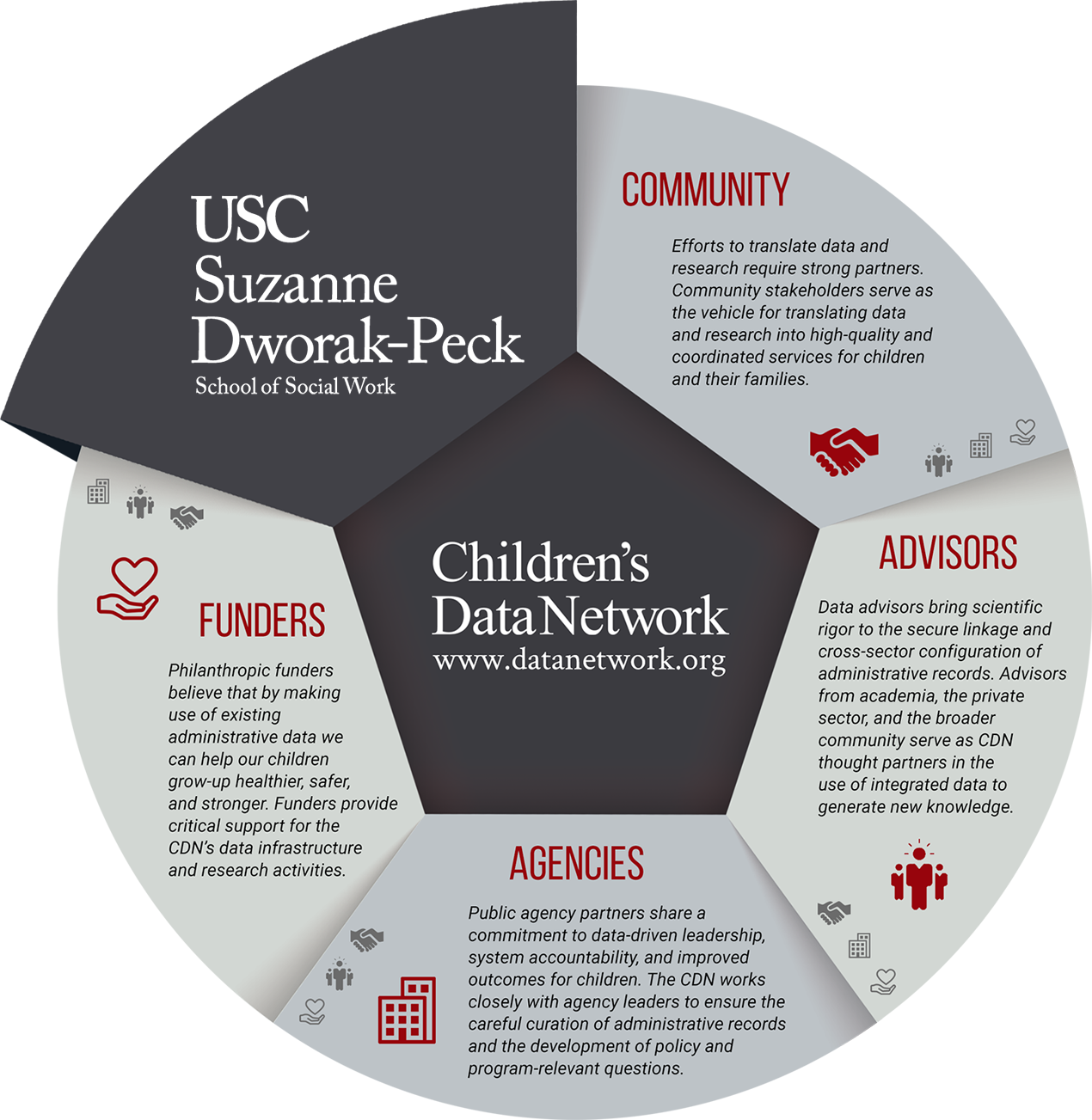-

Harnessing the scientific potential of linked, administrative data to inform children’s programs and policies.
-

Harnessing the scientific potential of linked, administrative data to inform children’s programs and policies.
-

Harnessing the scientific potential of linked, administrative data to inform children’s programs and policies.
-

Harnessing the scientific potential of linked, administrative data to inform children’s programs and policies.
-

Harnessing the scientific potential of linked, administrative data to inform children’s programs and policies.
Harnessing the scientific potential of linked, administrative data to inform children’s programs and policies.
Making Smarter Use of Data Together
The Children’s Data Network is a data and research collaborative focused on the linkage and analysis of administrative records. In partnership with public agencies, philanthropic funders, and community stakeholders, we seek to generate knowledge and advance evidence-rich policies that will improve the health, safety, and well-being of our children.
Each person in the world creates a Book of Life. This Book starts with birth and ends with death. Its pages are made up of the records of the principal events in life. Record linkage is the name given to the process of assembling the pages of this Book…

A Data and Research Collaborative
The Children’s Data Network receives essential infrastructure funding from First 5 LA and the Conrad N. Hilton Foundation, with additional project support from other philanthropic and public partners.


Latest News
Dr. Emily Putnam-Hornstein to be inducted into the American Academy of Social Work and Social Welfare
Written on
CDN Co-Founder and Director, Emily Putnam-Hornstein, has been named an American Academy of Social Work and Social Welfare Fellow. She and seven eminent colleagues in the 2024 class will be inducted this January at the annual Society for Social Work and Research Conference in Washington, D.C.
This award comes in recognition of Emily’s groundbreaking work to develop and examine data and algorithmic tools that can improve the accuracy and consistency of decisions made by child protection agencies. Her scholarship has provided insight into where resources may be used to better understand, and provide support for, vulnerable children and their families.
Please visit the following announcement to read more about Emily’s work and this well-deserved honor: UNC’s Putnam-Hornstein named a 2024 AASWSW fellow
Congratulations, Emily!
Seeking California Labor and Delivery Provider Input for New Research Study
Written on
Julia Reddy, research assistant at the CDN and doctoral student at UNC-Chapel Hill is conducting a qualitative study of California labor and delivery providers to learn about the decision to notify child protection systems (CPS) following substance exposed deliveries. She is currently recruiting hospital providers in California – nurses, social workers, midwives, physicians – who make decisions about CPS reporting after birth. Interviews will be conducted in person (in January 2024) or over zoom between November 2023 and February 2024.
Julia notes: “This dissertation research study is focused on policies and practices related to child protection system reporting (or maltreatment referrals) following births where there was identified prenatal substance use. I am interested in the clarity and utility of various policies, and the tools or resources that help or hinder providers who are making these determinations at the time of delivery.
I am interviewing labor and delivery providers, including doctors, midwives, nurses, and social workers, who are part of the decision-making team for determining whether to file a CPS referral following a substance exposed birth. I would like to speak to providers who work at hospitals in California. The interview will last about 1.5 hours and no identifying information will be retained or disclosed. I will interview you as an individual provider; your place of employment will not be recorded or connected in any way to your responses. This study has IRB approval (UNC IRB #22-3294).”
If you work at a California birth hospital and have participated in CPS reporting decisions following a substance-exposed birth, and you are interested in learning more about this research study, please visit: https://jreddy0.wixsite.com/cps-reporting-study.
CDN Executive Director Presents to Legislative Staff about Children’s Data
Written on
Owing to her knowledge about the landscape of data about children in California and experience with data integration and visualization initiatives, Dr. Regan Foust was invited to serve as a panelist at a recent California Policy Collaborative event. She and her esteemed co-panelists, Dr. Martha Dominguez, Deputy Director of the Program Innovation and Evaluation Division at First 5 California and Jacqueline Barocio, Fiscal and Policy Analyst at the Legislative Analyst’s Office, discussed the demographics, health, and well-being of California’s young child population with staff from various offices in the California State legislature. Dr. Foust’s remarks highlighted what we do and do not know about young children given the state of available data, and what we hope to know soon as emerging initiatives, such as the Agency-wide CalHHS Record Reconciliations, Cradle-to-Career (C2C) Data System, and Early Childhood Integrated Data System, progress.

1150 South Olive Street, Suite 1400
Los Angeles, CA 90015
Los Angeles, CA 90015
General Questions
Connect
Newsletter
Sign up for our mailing list to stay up to date with the Children's Data Network's latest research and news developments.
©2020 Datanetwork.org
#





